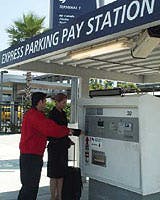NEW OPTIONS IN PARKING
Increasing security, efficiencies
By Lindsay M. Hitch, Assistant Editor
August 2001
Airport parking has seen a number of technological advancements in the last few years. Two of note are the Pay on Foot pre-pay service, already popular in Europe, and Cernium’s recently introduced Parking Sentry.
PED PAYMENT
World travelers may already be familiar
with Pay on Foot services. In North America, the systems are slowly gaining
acceptance, says Steve Burton, president of Ace Parking.
The Pay on Foot system consists of an automatic
payment machine typically located inside the airport terminal near the
parking facility. On their way out to the parking area, passengers have
the option to pay before getting in their cars.
One such system is in place at San Diego
International Airport, managed by Lindbergh Parking in partnership with
Ace Parking. That system includes express exit lanes for those who have
prepayed, allowing them faster exiting.
The system is popular with airport patrons.
Burton says that an average of 44 percent of those parking at the airport
opt to "pay on foot".
And since installation in 1995, Burton says
the system has eliminated 32 hrs./day in staffing, generating savings
of $150,000 each year in manpower.
"The key to a successful implementation,"
says Burton, "is the public awareness campaign." People have
to know it’s available and how to use it, he explains.
Educating customers is also among the concerns
of Paul Benoit, president and CEO of Ottawa International Airport. Another
is the option to not use the system. "I want the customer to be able
to have the choice."
A number of companies manufacture Pay on
Foot equipment, including Amano Cincinnati (Bradley Int’l, Hartford),
Ascom (San Diego Int’l), Federal APD (Detroit Metro Wayne County
Airport), and Scheidit & Bachmann (Seattle-Tacoma Int’l).
COMBINING SECURITY,PARKING
Cernium’s Parking Sentry is designed
specifically to provide security surveillance in parking structures. The
system enables security personnel to monitor more cameras with less equipment
than standard closed circuit TV surveillance systems.
The Parking Sentry uses software with behavior
analysis capabilities, recognizing human versus vehicle motion and identifying
threatening events. The software evaluates detected events for security
personnel based on the severity of the threat, focusing their attention
on the cameras detecting trouble.
The system prioritizes events based on four
basic actions: multiple people moving toward each other from different
start points; one or more people moving quickly; multiple people in view
not moving toward each other; and one person alone.
Aside from those basic combinations, the
system recognizes other human actions: a person falling down; a person
wandering, appearing lost or suspicious; a person hovering outside a vehicle;
a car moving significantly faster than most in view.
The ability of the system itself to identify
troublesome behavior allows guards to monitor many more cameras than normal.
By only seeing cameras diplaying suspicious events, the guards do not
waste time and energy monitoring all cameras.
"This technology is valuable in multi-camera
systems that would normally require a substantial security monitoring
staff," explains Maurice Garutte, chief technology officer. "Parking
Sentry nearly eliminates the need for such staffing."
Installation of the Parking Sentry was recently
completed at Ronald Reagan Washington National Airport in Washington,
D.C.
For additional information on Cernium and
the Parking Sentry, visit www.cernium.com or call (877) 968-8383.





